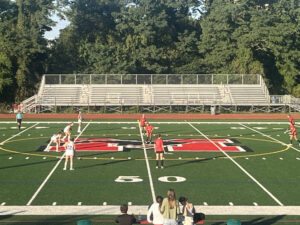Steady rain, which began in the region yesterday and that is expected to persist through Saturday, has swiftly allayed worries about the potential impact of the drought conditions here, but Falls Church City Manager Wyatt Shields noted that severe problems persist for much of Virginia and it remains yet uncertain how much good the current rain will do for this area.
The Washington, D.C., area set an all-time record for successive days without measurable rain last week, September was the driest month on record, and the southeastern U.S. as a whole faces severe drought conditions. But because Falls Church’s water system is among those in the region which gets its water out of the Potomac River, the threat of shortages has been minimal to date.
That’s because the headwaters of the Potomac are outside the drought area and have been receiving rainfall.
Not so fortunate are water systems that rely on area reservoirs, such as that of the City of Fairfax, that draws much of its water from two reservoirs in Loudoun County. Yellow cardboard signs, posted on roadways throughout that city urging voluntary water restrictions, were put up on Oct. 5 and were slated to remain until significant rain returned to the area.
Other parts of Virginia are even more severely affected, with much of the state declared a disaster area by the U.S. Department of Agriculture. U.S. Senator James Webb produced an audio public service announcement yesterday encouraging farmers in the state to find information on emergency loans and government assistance services, where they can buy or sell hay, and see crop status reports on a website set up by the Virginia Department of Agriculture. That site is www.vdacs.virginia.gov.
Shields reported to the City Council here Monday that he’s been involved in region-wide conference calls set up through the Council of Governments to assess the situation.
He said that in the case of the Falls Church water system, which serves 120,000 customers in Falls Church, McLean, Tysons Corner and Langley, the trigger for introducing voluntary or mandatory conservation measures is the point at which the Jennings Randolph Reservoir needs to be opened to augment the flow of the Potomac.
That is also true for the systems that serve the rest of Fairfax County, Arlington, Maryland and District water systems that similarly draw their water from the Potomac. Three major water systems drawing from the Potomac supply about 95% of the water in the greater Washington, D.C., metropolitan area.
The Jennings Randolph Reservoir, a man-made lake built in the 1960s for flood control purposes by the U.S. Army Corps of Engineers, is located at the very upper regions of the northern branch of the Potomac River basin. It bridges Garrett County, Maryland and Mineral County, West Virginia and stores 13 billion gallons of water that may be tapped to keep water levels in the Potomac at necessary levels to serve water system needs in this area. However, water from that reservoir must travel seven to nine days to reach here.
The smaller Little Seneca Reservoir in Montgomery County, Maryland, holding four billion gallons, can also be tapped for much more limited use.
In the City of Fairfax, the implementation of voluntary water restrictions on Oct. 5 urged refraining from watering lawns and shrubs, washing cars (except at commercial businesses that recycle their water), using water-demanding amenities such as ornamental ponds or pools, using hoses or sprinkler systems to water large areas of home properties, or taking long showers.












